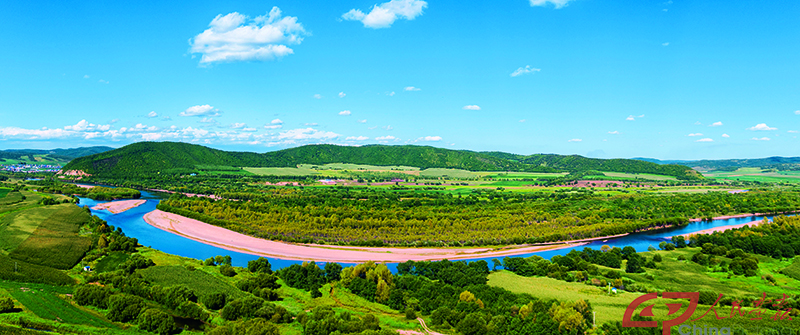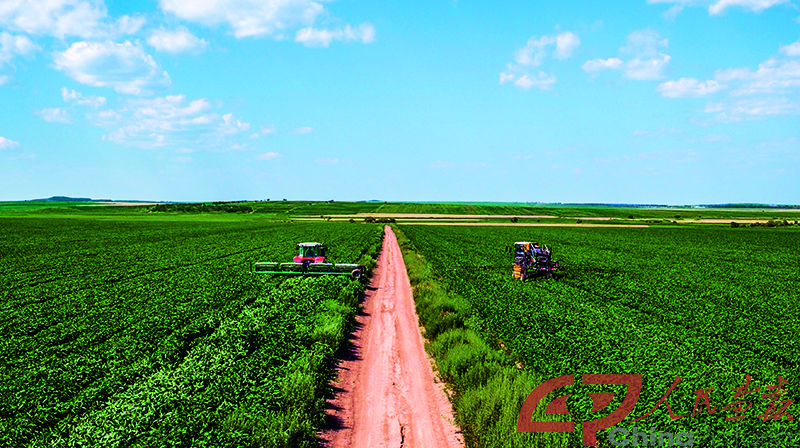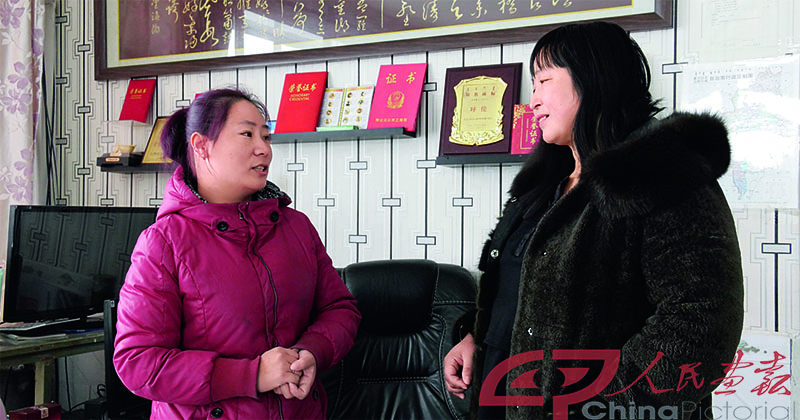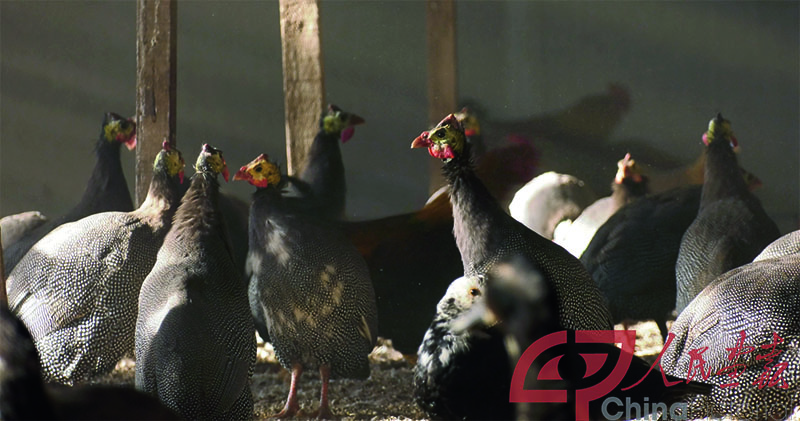Agricultural Supply-side Structural Reform in Morin Dawa Daur Autonomous Banner

Established in 1958, Morin Dawa Daur Autonomous Banner under the administration of Hulunbuir City of the Inner Mongolia Autonomous Region, is one of the only three ethnic autonomous banners in China. Located in one of the only three black soil areas in the world, the banner is gifted with abundant water resources and fertile land, providing good conditions for agriculture and livestock production.
In the Daur language, “Morin Dawa” means “mountainous region that even fine horses cannot traverse.” Due to inconvenient transportation conditions, the banner cannot be reached by plane or train and remains only accessible by car or bus. It takes five to six hours to reach the nearest major city, Harbin. In the past, poor transportation impeded the development of local agriculture and hindered improvements in the quality of life of local farmers.
At the Central Rural Work Conference held from December 24 to 25, 2015, the Chinese government pledged to take steps to promote “agricultural supply-side structural reform.” Under guidance and with assistance from the government and through efforts of farmers, the reform aims to enhance the quality and output of agricultural products to meet consumers’ demand, thus increasing farmers’ income and promoting agricultural and rural modernization.
In the process of implementing the agricultural supply-side structural reform, the government of Morin Dawa Daur Autonomous Banner appraised its own conditions and placed reform focus in the following areas: First, adjust the structures of planting and livestock production to better meet the demands of consumers and to industrialize both planting and livestock production. Second, build the “internet + agriculture” mode, establish agricultural cooperatives in various forms, set up online sales platforms, and break restrictions caused by poor transportation conditions. Using the internet and logistics to connect the banner with the outside world, Morin Dawa has improved the quality of its agricultural products and raised local farmers’ income significantly.

Machineries work in the soybean field in Morin Dawa Daur Autonomous Banner. The banner is dubbed the “center of soybeans” thanks to its annual cultivation area of around 266,667 hectares and average annual yield of 600,000 to 750,000 tons.
Morin Dawa is the base for the pork industry, the breeding base for Simmental cattle and a hub for husbandry of fine-wool sheep and the poultry industry in Hulunbuir. “The focus of our structural reform is to combine farming and animal husbandry, and make farming serve the animal husbandry,” explains Tian Yuanshan, head of the agricultural bureau of Morin Dawa Daur Autonomous Banner. In 2017, the banner began to replace its grain crops with fodder cultivation and planted around 5,333 hectares of feed grains. Additionally, the banner planted more than 20,000 hectares of annual and perennial forage grasses. Herding on the grasslands was no longer the only avenue, and dry-lot feeding and semi-confinement feeding began to emerge. Now, the banner is home to 777 large-scale livestock farms and 54 villages specializing in livestock production. Through the efforts of these livestock farms and farmers, the banner’s development in animal husbandry has reached a new level and its ecological protection is much stronger.

Tian Yuanshan, head of the agricultural bureau of Morin Dawa Daur Autonomous Banner. During its agricultural supply-side structural reform drive, the banner government has placed reform focus on the industrialization of both planting and livestock production as well as building the “internet + agriculture” mode.
The banner is dubbed the center of soybeans thanks to its annual cultivation area of around 266,667 hectares and average annual yield of 600,000 to 750,000 tons. Soybeans produced in the banner were exported to Japan and South Korea. In recent years, facing stiff competition from imported soybeans, locally produced soybeans witnessed a drop in cultivation area and are now plagued by difficulties related to pricing, storage and transit. In 2013, the banner changed its practice of only planting soybeans to be processed into oil and began to promote a new variety of soybeans fit for human consumption. High in protein, soybeans occupy an important place in the Chinese diet. Both soy milk for breakfast and tofu at lunch and dinner require soybeans. The banner now specializes in producing soybeans suitable for making food and processes the soybeans to be used as raw materials for health products such as lecithin and isoflavones.
In 2017, the banner proposed the “internet + agriculture” strategy, which is also known as smart agriculture. One of the projects under its framework involved soybean cultivation. A total of 67 farming households from 38 villages, most of whom were poverty-stricken, were organized by the government to plant organic soybeans, mung beans, and other beans near their homes. The entire production process remained under the guidance and supervision of 38 agro-technicians. To guarantee the quality of these beans, no pesticides or fertilizers were allowed.
Internet technologies are now widely used in the banner. On each piece of land, cameras monitor the entire agricultural production and management process. Through online promotion, some urban residents looking for a better-quality life rent pieces of land from local farmers. They pay the farmers rental in advance and “hire” them to perform plantation and management. After the harvest, they pay farmers fees for their work and receive the yields. Unrented pieces of land return to the management of local agricultural cooperatives.
In 2016, the banner government established an innovation and creativity experience museum to promote and sell its local agricultural and peripheral products, ethnic costumes and jade products, as well as to establish a platform for its household service industry and health industry. The ultimate purpose of establishing the museum is to increase incomes of local enterprises and promote employment of poverty-stricken farmers. “Today, we have more than 300 online shops, which have created more than 1,000 jobs,” says Chen Linlin, a government worker responsible for construction of the museum.
In a remote place like Morin Dawa Daur Autonomous Banner, establishing cooperatives and employing the “internet + agriculture” strategy have provided farmers with platforms to sell their products. Furthermore, it has provided locals with new thinking modes, business patterns and lifestyles.
Still relying on agriculture, the banner is home to a number of big growers. Since 2015 when the banner began to implement the “internet + agriculture”strategy, many local agricultural cooperatives were established in succession, including corn, soybean, pork and agricultural machinery cooperatives.
Yue Guiling is chairman of the Xinxingyuan Professional Plantation Cooperative of Morin Dawa Daur Autonomous Banner and president of the banner’s e-commerce association. The plantation cooperative she operates was established in October 2010 to promote the planting, processing, selling, and storage of soybeans, other beans and side crops. The cooperative now manages a plantation area of 593 hectares and a processing area of more than 8,700 square meters and includes 32 households as members.

Yue Guiling (right) discusses the rice sales situation with Liu Dongling, head of a local rice cooperative. Since 2015 when the banner began to implement the “internet + agriculture” strategy, many local agricultural cooperatives were established in succession, including corn, soy, pork and agricultural machinery cooperatives.
With this cooperative as her base, Yue contacted another 12 cooperatives in seven townships and villages of the banner, including a homegrown chicken cooperative, a rice cultivation cooperative and a tobacco plantation cooperative. These cooperatives were united to form a major comprehensive group with products featuring centralized package and branding as well as centralized training of manpower. Products from these cooperatives can be found for sale in the experience museum. Through internet promotion and online orders, products from these cooperatives are now sold all over the country. Now, Yue manages 13 cooperatives, each with a membership of about 30 to 40 farming households. And around 500 farming households have benefited from these cooperatives.
On the “internet + agriculture” strategy, Yue has much to say: “It primarily solves sales problems plaguing agricultural products. In the traditional sales method, many agricultural products are hard to sell at decent prices. If farmers lose money, they quickly lose motivation to continue planting. The new strategy places emphasis on quality. For example, a kilogram of ordinary soybeans generally sells at around four yuan, but a kilogram of top-shelf organic soybeans sells at 12 to 14 yuan. For farmers planting organic soybeans, they can escape poverty in just one year. Considering factors such as subsidies from the government, farmers can enjoy a good income and much higher standard of living.”
Grain production remains the pillar of the banner’s agriculture. The banner has been honored as a major grain producer for 14 consecutive years, and its comprehensive grain productivity increases with each passing year. The banner government has spared no efforts to make these achievements. To solve the farmer shortage caused by the exodus of young people to cities, the local government has encouraged and supported new business entities including big growers, cooperatives, family farms and processing enterprises for agricultural and livestock products. An industrial chain from plantation, breeding, acquisition, storage, processing to sales has been formed. At present, the banner is home to 972 big growers, each managing more than 33 hectares of plantation areas and altogether cultivating an area of 58,667 hectares. The banner is also home to 621 large livestock farms, each with more than 500 head of livestock which are full grown and ready for slaughter, as well as 2,242 family farms and 2,671 cooperatives.

A local poultry farm. The banner is home to various livestock and poultry farms. Through these large-scale farms, the banner government pushes the development of livestock and poultry industries to a new level and industrialization has been taking shape.
The banner government also founded a “grain bank.” Grain is collected and stored free of charge, just like money in the bank. Farmers can decide when they want to sell their grains and get the price on the day they choose. Through such practices, farmers can sell most of their grain at the best market price and maximize their profits.
“The loose production and business model run by each individual household in the past has been replaced by new business entities,” says Tian Yuanshan. “In terms of the planting industry, unified seeding, harvesting and technical guidance and training have lowered the production costs of necessary items such as seeds and pesticides. Unified sales enhance our competitiveness and bargaining power. With the sale prices for our agricultural products raised, farmers’ incomes have increased. In this way, not only has the rural economy been developed, but farmers have been lifted out of poverty and acquired wealth.”